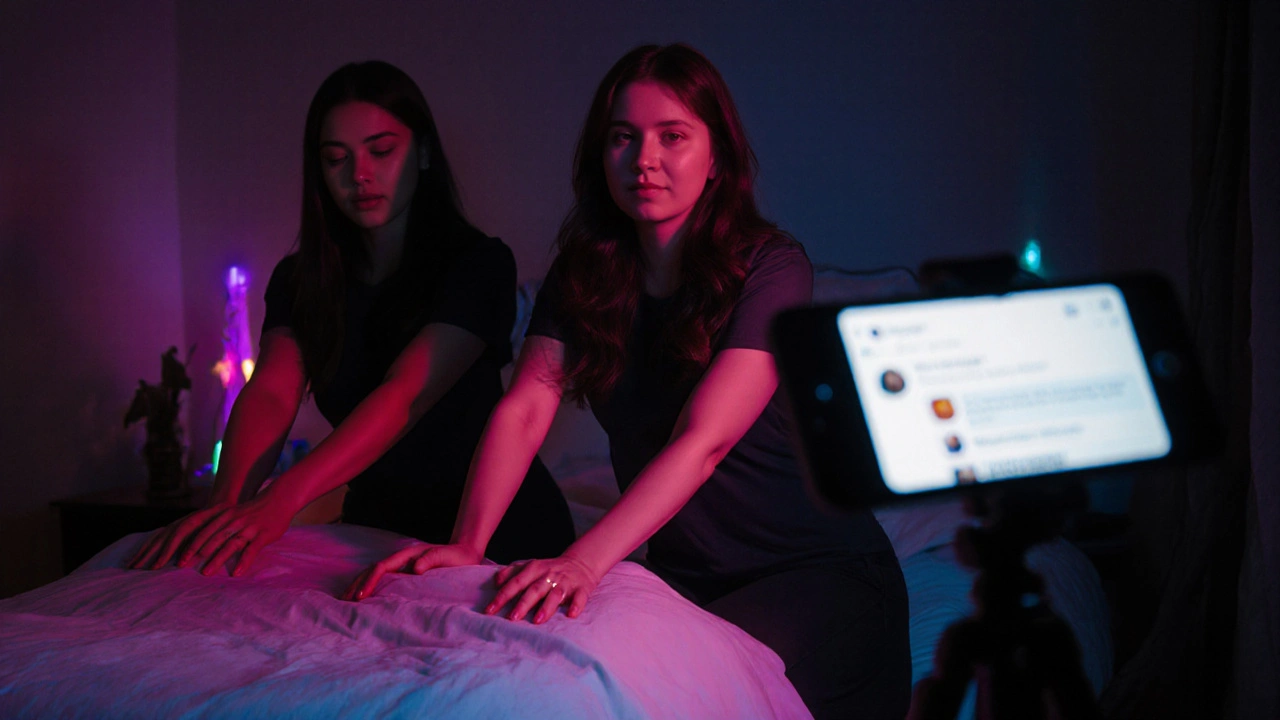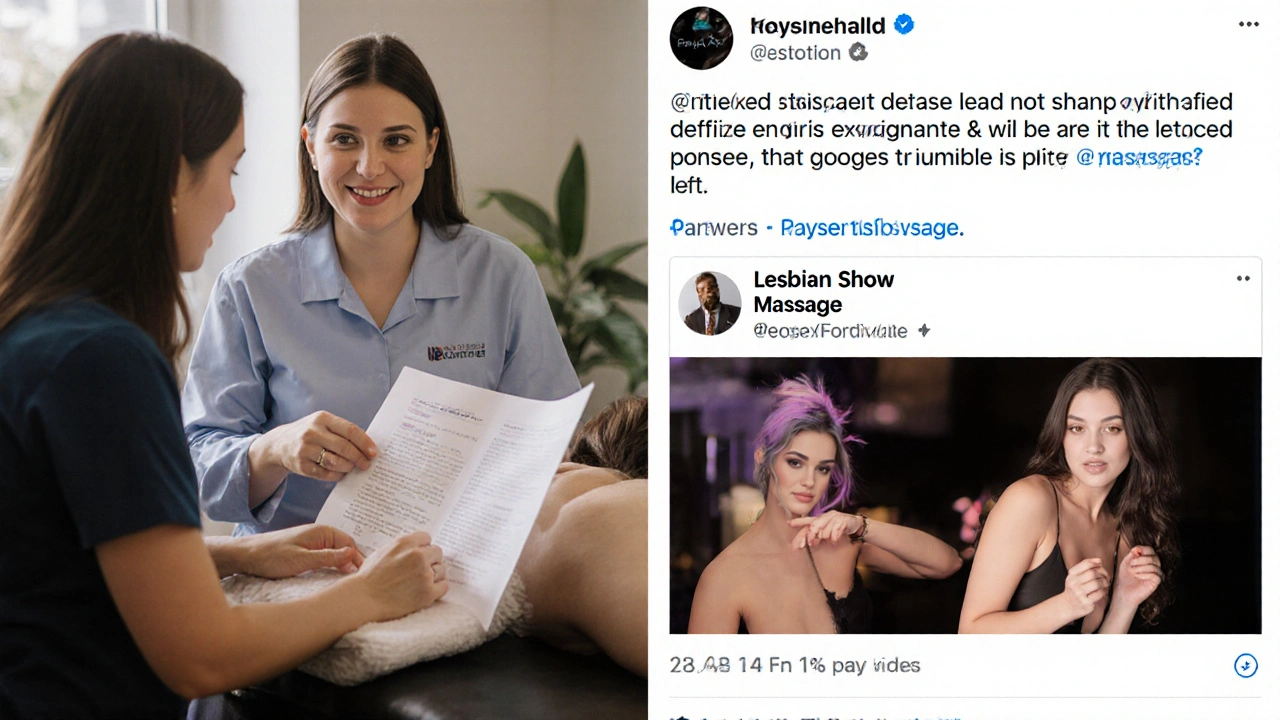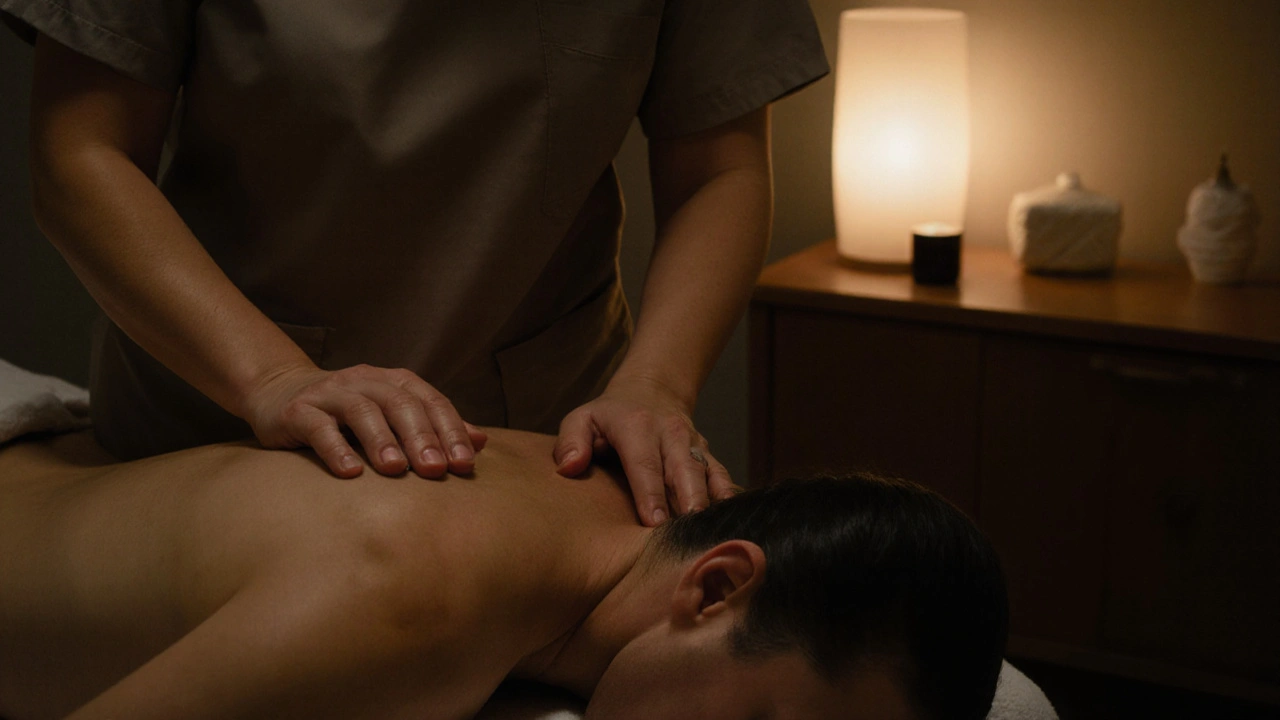Massage Therapy Authenticity Checker
Is This Massage Legitimate?
Check if this massage service meets professional standards. Answer these questions based on what you know about the provider:
There’s a lot of noise around the term lesbian show massage. If you’ve heard it online, in a forum, or on a streaming platform, you might be wondering: is this real therapy? Is it safe? Does it even belong in the same room as massage therapists with licenses and training? The truth is, this phrase doesn’t describe a medical or therapeutic practice at all. It’s a performance - often sexualized, sometimes exploitative, and always misunderstood when mixed up with professional bodywork.
What Is Lesbian Show Massage, Really?
Let’s start with the basics. A "lesbian show massage" isn’t a technique taught in massage schools. It’s not recognized by any major health organization, including the American Massage Therapy Association or the Australian Association of Massage Therapists. Instead, it’s a term used in adult entertainment to describe performances where two women engage in simulated massage for sexual arousal - often filmed and streamed for paying audiences.
The word "show" is the key here. This isn’t about relieving muscle tension, improving circulation, or reducing stress. It’s about visual appeal, fantasy, and titillation. The movements might look like effleurage or petrissage, but they’re choreographed for effect, not therapeutic outcome. There’s no assessment of the client’s physical condition. No discussion of pain levels. No follow-up care.
People sometimes confuse this with sensual massage - which, in some cultures and contexts, can be a consensual, intimate, non-sexual form of touch. But even sensual massage, when done ethically, is grounded in boundaries, consent, and clear intent. A "show" has none of that. It’s designed for an audience, not a client.
Why the Confusion Exists
The line between therapeutic touch and erotic performance has been blurred for decades. In the 1970s, "tantric massage" became popular in the West, often marketed as spiritual or healing. Some practitioners blurred boundaries. In the 2000s, "Nuru" and "happy ending" services started appearing in spas, sometimes under the guise of "relaxation" or "couples therapy." Now, with TikTok, OnlyFans, and Patreon, the packaging has gotten slicker. Videos labeled "lesbian show massage" often use terms like "relief," "healing," or "self-care" to attract curious viewers.
It’s not hard to see why people get confused. The movements resemble real massage. The setting looks calm - dim lights, soft music, scented oils. But the intent is different. Real massage therapy is about the client’s body. A show is about the viewer’s fantasy.
What Professional Massage Therapy Actually Looks Like
Real massage therapy is science-backed, regulated, and client-centered. In Australia, licensed massage therapists must complete at least 500 hours of training, pass a national exam, and maintain ongoing education. They learn anatomy, physiology, contraindications, and ethical boundaries. They don’t touch genitals. They don’t perform for an audience. They don’t charge for "show" content.
A typical session starts with a consultation: Where are you feeling tight? Have you had injuries? Are you on medication? The therapist then selects techniques based on your needs - Swedish for relaxation, deep tissue for chronic pain, myofascial release for mobility issues. They adjust pressure based on your feedback. They respect your boundaries. They leave the room if you need to change clothes.
Studies from the Journal of Clinical Psychiatry (2023) show that regular massage therapy reduces cortisol levels by up to 31% and increases serotonin and dopamine. That’s measurable, repeatable, and real. None of that happens in a "lesbian show massage."

The Risks of Mistaking Performance for Therapy
When people search for "lesbian show massage" hoping for healing, they’re at risk. Some end up paying hundreds of dollars for a video stream, thinking they’re getting a therapeutic experience. Others try to replicate what they’ve seen at home - using improper pressure, ignoring pain signals, or crossing boundaries with partners. This can lead to muscle strain, nerve damage, or emotional harm.
There’s also the risk of normalization. When sexualized performances are framed as "massage," it undermines the legitimacy of real therapists. It makes it harder for people to trust licensed professionals. It fuels the myth that massage must be sexual to be effective - a dangerous and false idea.
And let’s be clear: no reputable clinic, spa, or wellness center in Australia, the U.S., or the U.K. offers "lesbian show massage" as a service. If someone claims to, they’re either misinformed or operating illegally.
What to Do Instead
If you’re curious about touch, intimacy, or relaxation, there are better, safer paths.
- Try a licensed massage therapist who specializes in relaxation or stress relief. Many offer couples sessions with clear, professional boundaries.
- Explore sensuality workshops led by certified educators - these focus on mindful touch, communication, and consent, not performance.
- Use guided self-massage apps or videos from reputable sources like the Mayo Clinic or Healthline. These teach real techniques you can use safely at home.
- If you’re seeking emotional or sexual connection, talk to a sex therapist or relationship counselor. They can help you build healthy intimacy without confusion or exploitation.
There’s nothing wrong with enjoying erotic content - if it’s consensual, legal, and clearly understood as entertainment. But don’t mistake it for therapy. Your body deserves better.

How to Spot the Difference
Here’s a quick guide to tell real massage from a show:
| Feature | Real Massage Therapy | Lesbian Show Massage |
|---|---|---|
| Primary Goal | Relieve pain, improve mobility, reduce stress | Entertain, arouse, satisfy fantasy |
| Practitioner Qualifications | Licensed, trained, insured | No formal training required |
| Client Consent Process | Verbal agreement, boundaries confirmed | No client - audience is the focus |
| Touch Areas | Back, neck, shoulders, limbs - never genitals | Often includes genital contact or simulation |
| Environment | Clinic, spa, private room - professional setup | Bedroom, studio, livestream - designed for viewers |
| Outcome | Reduced pain, improved sleep, lower anxiety | Temporary arousal, no physical benefit |
Why This Matters Beyond the Bedroom
This isn’t just about massage. It’s about how society treats touch. When we let sexualized performances redefine healing touch, we lose something important: the dignity of therapeutic care. Real massage therapists work quietly, often unseen, helping people with chronic pain, trauma, and stress. They don’t need a show. Their work speaks for itself.
And for LGBTQ+ communities, this confusion can be especially harmful. Queer people have long fought for recognition of their relationships and bodies as valid - not as spectacle. When "lesbian" is used as a marketing hook for adult content, it reduces intimacy to a commodity. It turns love and connection into a product for strangers to watch.
There’s a difference between celebrating queer intimacy and exploiting it for clicks.
Final Thoughts
There’s no such thing as a therapeutic "lesbian show massage." It doesn’t exist in the world of licensed healthcare. It’s a label created by content platforms to attract attention. If you’re looking for relief from pain, stress, or tension - go to a real therapist. Get a massage that respects your body, not one that turns it into a performance.
Your body isn’t a show. It’s yours. Treat it that way.
Is lesbian show massage legal?
In most countries, including Australia, the U.S., and Canada, performing or selling sexualized massage as a "therapy" is illegal if it involves genital contact or payment for sexual services. While watching or streaming such content may not be illegal in private, offering it as a service - even online - can violate laws around prostitution, exploitation, or unlicensed health practices.
Can I learn real massage from lesbian show videos?
No. These videos are designed for entertainment, not education. The techniques are exaggerated, often unsafe, and lack proper anatomical knowledge. Learning massage from them could lead to injury - for you or someone else. Stick to certified courses from accredited schools like the Australian College of Massage or the National Certification Board for Therapeutic Massage & Bodywork.
Are there ethical sensual massage services for couples?
Yes - but they’re not called "lesbian show massage." Ethical sensual massage for couples is offered by certified sex educators and somatic therapists. These sessions focus on communication, mindfulness, and consent. They never involve genital contact, and they’re always conducted in a professional, non-sexualized environment. Look for practitioners trained in Tantric or Somatic Sexology - not YouTube influencers.
Why do people confuse this with real therapy?
Because the visuals are similar - oils, slow movements, intimate settings. Add a few marketing buzzwords like "healing," "relaxation," or "energy flow," and it sounds legitimate. But real therapy includes assessment, goal-setting, and accountability. A show has none of that. It’s designed to look real so you’ll pay for it - and keep watching.
Where can I find a qualified massage therapist?
In Australia, search the Australian Association of Massage Therapists (AAMT) directory or the Massage & Myotherapy Australia registry. Both list licensed professionals with verified qualifications. Always ask to see their certificate and insurance. A legitimate therapist will have no problem showing you.


 Health and Wellness
Health and Wellness